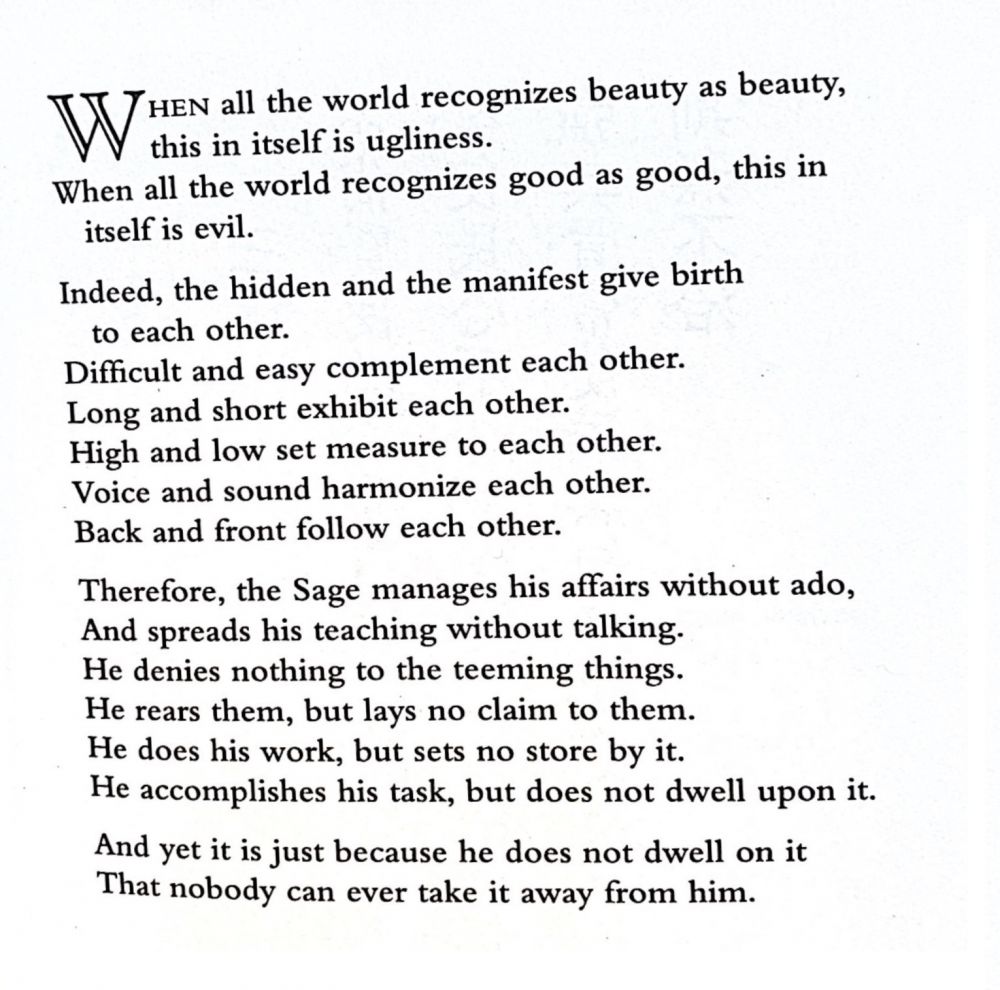隨意、自由、快樂的小天地
學習是一件快樂的事情
正文
道德經上篇:《道經》
第二章
【原文】
天下皆知美之為美,斯惡已①;皆知善之為善,斯不善已。有無相生,難易相成,長短相形,高下相盈,音聲相和②,前後相隨,恒也。是以聖人處無為之事⑧,行不言之教;萬物作而弗始④,生而弗有,為而弗恃(shì)⑤, 功成而弗居。夫唯弗居,是以不去。
【注釋】
①已:語氣詞,可譯為“了”。
②音聲:古代音和聲是有區別的。單調的、無節奏的叫“聲”,複雜的、有節奏的叫“音”。
③是以:疑為後人所加。本章的前八句是老子的相對論,後八句是老子的政治論,文意不相連。聖人:老子理想中的“與道同體”的人物,他與儒家聖人有很大不同,是“有道的人”。
④始:管理、幹涉的意思。
⑤恃(shì):依賴,依靠。
【譯文】
天下的人都知道美之所以為美,醜的觀念也就出來了;都知道善之所以為善,惡的觀念也就產生了。“有”和“無”互相對立而產生,困難和容易互相矛盾而促成,長和短互相比較才形成,高和下互相對照才有分別,音和聲由於對立才顯得和諧動聽,前和後彼此排列才有順序,這是永遠如此的。因此,有道的人用“無為”的法則來對待世事,用“不言”的方式施行教化;讓萬物興起而不加倡導,生養萬物而不據為已有;撫育萬物但不自恃己能,立下了功勳而不自我誇耀。正因為他不居功,所以他的功績就不會失去。
English Translation
Version 1:by Daniel Baida Su and Shangyu Chen
If everyone knows beauty as beautiful, there is already ugliness;
If everyone knows kindness as kind, there is already evil.
Being and non-being beget each other;
The difficult and the easy complement each other;
The long and the short contrast with each other;
The high and the low point to each other;
The voice and its echo resound with each other;
Before and after follow each other.
Therefore, the Holy One acts without effort and teaches without speaking.
All things rise from him, yet he claims no sovereignty;
He multiplies all yet claims no possession;
He benefits all yet expects no return;
He accomplishes all yet claims no credit;
He claims no credit yet endures forever.
If everyone knows kindness as kind, there is already evil.
Being and non-being beget each other;
The difficult and the easy complement each other;
The long and the short contrast with each other;
The high and the low point to each other;
The voice and its echo resound with each other;
Before and after follow each other.
Therefore, the Holy One acts without effort and teaches without speaking.
All things rise from him, yet he claims no sovereignty;
He multiplies all yet claims no possession;
He benefits all yet expects no return;
He accomplishes all yet claims no credit;
He claims no credit yet endures forever.
Version 2:by John C. H. Wu

評論
目前還沒有任何評論
登錄後才可評論.




